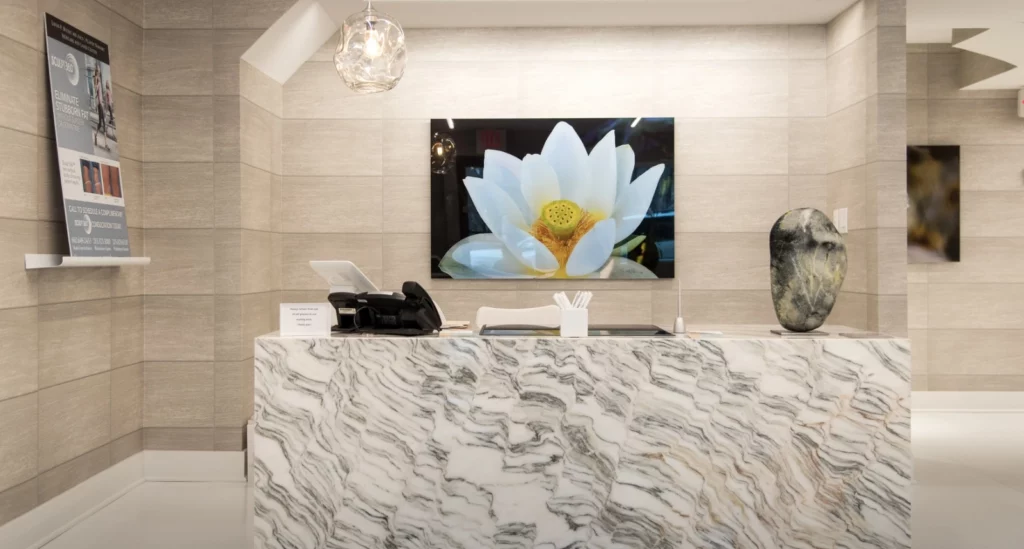
Louis P. Bucky, MD, FACS
Award-Winning, World-Renowned Plastic Surgeon
Premiere Destination for Finest Injectables & Skin Care
February 7, 2024
 The global beauty industry is set for continued growth in the coming years. McKinsey and Company predicts the worldwide market will be valued at $580 billion in 2027, growing 6% per year from its 2022 valuation of $430 billion.
The global beauty industry is set for continued growth in the coming years. McKinsey and Company predicts the worldwide market will be valued at $580 billion in 2027, growing 6% per year from its 2022 valuation of $430 billion.
Technological advancements are driving this growth. For instance, the cosmetic laser market is expected to grow by 19.1% by 2027. Meanwhile, the American Cosmetics Association points to a wide range of AI and AR applications that improve customer experiences and streamline product selection in the industry. Further, continued innovations in fat removal, skin tightening, and other procedures continue to make cosmetic care more accessible and cost-effective.
Here’s a look at different technologies that are already changing the beauty industry.
For years, cellulite has been a common challenge that many people face, but that hasn’t had a long-lasting or effective solution — until now. Although some may seek out fat removal treatments as a way to treat cellulite, it’s not necessarily the most effective treatment in the modern age. While exercise and replacing fat with muscle can reduce the appearance of cellulite, the dimples typically appear because the connective tissue underneath the skin — known as septa bands — tightens the muscles, pulls down on the skin, and brings up fat to the surface.
Recent technical advancements, such as the development of the Avéli device, have paved the way for substantial improvement in the appearance of cellulite. Avéli cellulite removal targets septa bands and breaks these bands up with relative ease within the buttocks and thighs, as well as a faster recovery time in comparison to other treatment options. In addition, this treatment is largely noninvasive — it can be performed in-office at most treatment centers without anesthesia.
Laser treatments offer diverse benefits to cosmetic patients. Ultimately, lasers cause stress to the skin, but their effects vary depending on what kind of laser is being used and what layer of skin it’s being used on.
For example, non-ablative lasers heat the cells underneath the top dermal layers, encouraging skin cells to produce more collagen. Ablative lasers, on the other hand, provide stress to the top layer of the skin, which encourages skin cells to reproduce. This kind of treatment is used to address skincare concerns like acne scars, hyperpigmentation, discoloration, aging, collagen loss, and elasticity loss.
Here are some of the most popular applications:
Advances in laser technology have made treatment more accessible. For example, original laser hair treatments only worked on people with dark hair and fair skin because the light targeted the pigment in the hair. Today’s tools and techniques account for differences in hair and skin tones, making the procedures safer for each patient.
These non-invasive skin and hair procedures require some aftercare to reduce redness or irritation. However, recovery time is limited, meaning people can have treatment and return to daily activities immediately.
Traditionally, cosmetic specialists perform visual inspection of patients’ skin to find issues and diagnose conditions. AI-assisted skin analysis performs a similar assessment, but it can collect more data on the state of a patient’s skin and analyze it immediately.
For instance, a smart skin analysis program, such as the Visia Complexion Analysis system, takes information about moisture levels, skin type, elasticity, pigmentation, and texture. AI tools like computer vision can help assess images of patients’ skin. The software can instantly assess the pictures and collect relevant data points.
This approach helps cosmetic professionals account for every variable. For instance, they can fine-tune treatments based on sensitivity or collagen levels. Also, AI can detect patterns and conditions invisible to the naked eye. Doctors can then make treatment and procedure decisions based on all available data. Also, they can diagnose skin diseases that they might have missed during a traditional examination.
Often, people have sought out skin tightening in the past through invasive procedures. However, with revolutionary methods such as microcoring and microneedling, the same effect can be achieved with minimal recovery time.
For one, the microcoring process involves removing microscopic rows of skin in an area, signaling the body to heal. After the healing process, the skin will be tighter than it was before without the appearance of wrinkles. As of right now, the FDA has approved Ellacore and microcoring procedures on the face, but many are hopeful that this scientific achievement can be applied to other areas of the body just as microneedling can.
Microneedling is nothing new, but certain innovations within the procedure have made it more effective than it previously was. Morpheus8 treatments, for example, use radiofrequency technology that heats, coagulates, and contracts the skin during the microneedling process. In comparison to microcuring, this process tightens the skin on many more areas of the body, such as the abdomen, legs, and neck. This technology also builds up collagen to reduce the appearance of wrinkles and stretch marks.
Cosmetic companies rely on augmented reality (AR) and virtual reality (VR) for both surgical and non-surgical purposes.
Virtual and augmented reality applications can alter images of patients to show them how they might look after cosmetic surgery or procedures like laser treatments or Botox. These AI-enhanced pictures help patients decide whether or not to go through with a procedure.
AR applications on smartphones can also help customers try certain cosmetic products before they purchase them. The software uses filters or overlays to show customers how they would look after using cosmetic products. This try-before-you-buy feature isn’t possible without modern technological developments. Makeup, hair dye, and other projects would be contaminated if the customer physically tried them.
Technological advances and new techniques make cosmetic procedures more accessible and less invasive. However, patients still need a trusted cosmetic care provider to help them with diagnoses, treatment decisions, and aftercare.
Not only can a provider help with these choices, but they can also assist you in weighing the advantages and drawbacks of each treatment and preparing for potential side effects. Cosmetic treatments, even those relying on cutting-edge technology, are only effective if properly timed and administered. You should only work with providers who have a proven track record in the treatments you choose to receive and have the proper training and education.

If you live in Philadelphia, Ardmore, or nearby communities in PA and would like more information on our practice, or if you would like to schedule a consultation with Dr. Bucky, please contact our office today.